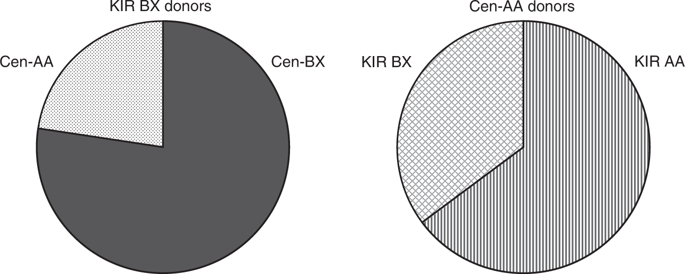Bone Marrow Transplantation ( IF 4.5 ) Pub Date : 2020-03-13 , DOI: 10.1038/s41409-020-0858-9 Will P Bultitude 1, 2 , Jennifer Schellekens 1, 2 , Richard M Szydlo 1, 3 , Chloe Anthias 1, 4 , Sarah A Cooley 5 , Jeffrey S Miller 6 , Daniel J Weisdorf 6 , Bronwen E Shaw 7 , Chrissy H Roberts 8 , Christian A Garcia-Sepulveda 9 , Julia Lee 10 , Rachel M Pearce 10 , Marie C Wilson 1, 10 , Michael N Potter 4 , Jenny L Byrne 11 , Nigel H Russell 11 , Stephen MacKinnon 12 , Adrian J Bloor 13 , Amit Patel 14 , I Grant McQuaker 15 , Ram Malladi 16 , Eleni Tholouli 17 , Kim Orchard 18 , Victoria T Potter 19 , J Alejandro Madrigal 1, 2 , Neema P Mayor 1, 2 , Steven G E Marsh 1, 2

|
The reported influence of donor Killer-cell Immunoglobulin-like Receptor (KIR) genes on the outcomes of haematopoietic cell transplantation (HCT) are contradictory, in part due to diversity of disease, donor sources, era and conditioning regimens within and between different studies. Here, we describe the results of a retrospective clinical analysis establishing the effect of donor KIR motifs on the outcomes of 119 HLA-matched, unrelated donor HCT for adult acute myeloid leukaemia (AML) using myeloablative conditioning (MAC) in a predominantly T-cell deplete (TCD) cohort. We observed that HCT involving donors with at least one KIR B haplotype were more likely to result in non-relapse mortality (NRM) than HCT involving donors with two KIR A haplotypes (p = 0.019). Upon separation of KIR haplotypes into their centromeric (Cen) and telomeric (Tel) motif structures, we demonstrated that the Cen-B motif was largely responsible for this effect (p = 0.001). When the cause of NRM was investigated further, infection was the dominant cause of death (p = 0.006). No evidence correlating donor KIR B haplotype with relapse risk was observed. The results from this analysis confirm previous findings in the unrelated, TCD, MAC transplant setting and imply a protective role for donor-encoded Cen-A motifs against infection in allogeneic HCT recipients.
中文翻译:

供体编码的着丝粒 KIR B 含量的存在增加了接受清髓性、T 细胞耗竭、HLA 匹配的 HCT 治疗 AML 的受者感染死亡的风险。
据报道,供体杀伤细胞免疫球蛋白样受体 (KIR) 基因对造血细胞移植 (HCT) 结果的影响是相互矛盾的,部分原因在于不同研究内部和之间的疾病、供体来源、时代和预处理方案的多样性。在这里,我们描述了一项回顾性临床分析的结果,该分析确定了供体 KIR 基序对 119 名 HLA 匹配、无关供体 HCT 治疗成人急性髓性白血病 (AML) 的结果的影响,该 HCT 在主要是 T 细胞中使用清髓性调理 (MAC)耗尽(TCD)队列。我们观察到,涉及具有至少一种 KIR B 单倍型供体的 HCT 比涉及具有两种 KIR A 单倍型供体的 HCT 更可能导致非复发死亡率 (NRM) ( p = 0.019)。在将 KIR 单倍型分离成它们的着丝粒 (Cen) 和端粒 (Tel) 基序结构后,我们证明了 Cen-B 基序在很大程度上是造成这种效应的原因 ( p = 0.001)。当进一步调查 NRM 的原因时,感染是主要的死亡原因 ( p = 0.006)。没有观察到供体 KIR B 单倍型与复发风险相关的证据。该分析的结果证实了先前在不相关的 TCD、MAC 移植环境中的发现,并暗示供体编码的 Cen-A 基序对同种异体 HCT 受者的感染具有保护作用。











































 京公网安备 11010802027423号
京公网安备 11010802027423号